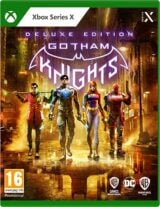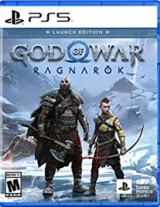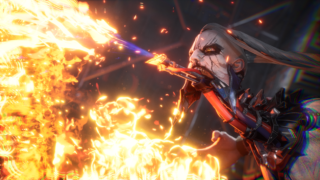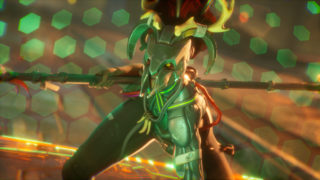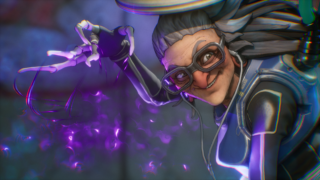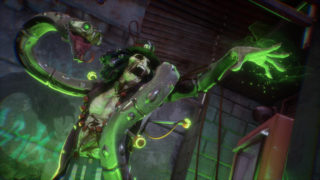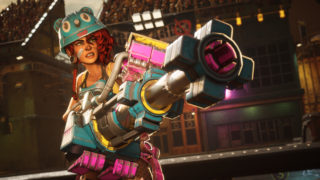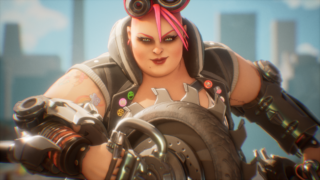How the DMC team got a second chance with Bleeding Edge
Behind the scenes: Ninja Theory returns to its arcade roots

Arguably no game has transformed a studio’s image and fortunes quite as much as Hellblade has for Ninja Theory.
The 2017 dark fantasy epic delivered an experience of a quality and uniqueness beyond what was expected of an independent studio, with stunning motion capture performances and an impressive commitment to its portrayal of real-world mental health issues.
The game was a commercial hit at a time its developer was struggling from a string of disappointments. Soon after, the company was rewarded when Microsoft paid an undisclosed sum to make Ninja Theory the newest addition to its first-party studio line-up.
But before Senua’s Sacrifice filled the Cambridge developer’s lobby full of BAFTA awards, it was best known for its arcade-style action games such as the Sony-published Heavenly Sword, and the criminally underrated Enslaved: Journey to the West.
But it was the Capcom collaboration, DMC: Devil May Cry, that lit the spark that led to Hellblade and the success that followed. The gritty and occasionally controversial reboot was well received by fans and critics alike, but it ultimately failed to deliver for the studio commercially. Despite selling over two million copies, the royalties Ninja Theory received were not enough for it to continue operating the way it had done in the past.
So the studio’s leaders devised a new plan: it would split its personnel into smaller teams to release shorter, focused games but with blockbuster quality. It’s this “independent triple-A” approach that led to the creation of the eight-hour Hellblade and changed Ninja Theory’s future entirely.

But far from ditching its arcade action roots, Ninja Theory’s new development philosophy empowered it to explore them further. Bleeding Edge is the second project to emerge from the studio’s “independent triple-A” mantra, and it has more than a few familiar faces among its development team.
“I did all the combat on DMC, so that’s why I wanted to make this project,” creative director Rahni Tucker explains. “Aaron [McElligott] was the lead environment artist on both games, plus we have the same lead coder, principle gameplay coder, principle environment artist… there’s quite a few DMC guys on this project.”
Speaking to VGC at Ninja Theory’s Cambridge, UK office, Tucker said the developer’s change of philosophy was never about moving away from the types of games it made in the past, but enabling it to continue making them without the risk of huge development teams.
“The ‘indie triple-A’ idea gives us the freedom to go ahead and make something we’re passionate about, but without a massive team of hundreds of people”
“I think that’s one of the great things about the model that Ninja Theory is following with Hellblade and Bleeding Edge: the ‘indie triple-A’ idea gives us the freedom to go ahead and make something we’re passionate about, but without a massive team of hundreds of people,” she said.
“You can be small and agile, and make something that maybe is a bit more risky and plays to your creative passions. You can take that chance with a smaller team and do something that’s maybe a bit more niche or specific to your passion, rather than trying to make a big game that’s everything to everybody.”
Bleeding Edge’s origins are in a prototype called Fighter. This simple 2v2 or 3v3 multiplayer combat game had players battling it out and using abilities, such as placing jump pads for other players to use. With its stick man graphics and missing effects Fighter looked simple, but it was enough to convince the Ninja Theory bosses to greenlight a full game.
“It was a compelling prototype: we could definitely tell there was something in it,” explains principle animator Warwick Mellow. “The game evolved from a combination of things the team was interested in playing and what we’re good at too.
“Ninja Theory is good at combat so it made sense to base a game around that, and we’d never really done multiplayer before… come to think of it we decided to make the hardest game we could with a small team!”
Fighter’s final form is Bleeding Edge, a 4v4 melee-focused fighting game with bold visuals and even louder characters. The game has two teams battling over various objectives, while pulling off signature abilities and ultimate powers to gain an advantage.
While it may initially sound similar to another hero battler in Overwatch, Bleeding Edge sets itself apart with its focus on melee brawling and a strong line-up of characters that would stand out even in Blizzard’s line-up.
One highlight is the dolphin-in-a-robot Mekko, whose bizarre water-powered moves and hilarious Japanese voiceover combine for probably the least dull character in any fighting game, ever.
Overall, the uniqueness of each character is a real delight. Maeve, a witch-themed character, is able to momentarily trap opponents in giant cages and sap their life force. Another favourite is Cass, a ballerina with deadly robot chicken legs, who has very low health but travels at great speed and is deadly up close.
One problem for Bleeding Edge might be that it’s not nearly as fun to watch is it is to play. The moment-to-moment gameplay is genuinely entertaining, but without an awareness of each character’s unique abilities we can see spectating the game’s frantic hack ‘n’ slash battles doing little more than confuse viewers.
Thankfully you don’t need to watch Bleeding Edge: you can jump in and try it.
It’s impossible to ignore the influence Game Pass has had on Ninja Theory and, possibly will have on Bleeding Edge too. The British developer builds exactly the sort of unique, creative experiences that Xbox would have been keen to acquire for its streaming service.
“I think that’s really exciting: being able to see people [via Game Pass] make more creative, different types of games and reignite genres that maybe have died a little bit”
But as we’ve seen with Netflix and the rise of genres such as stand up comedy, the model could also benefit games such as those Tucker loves to make, that didn’t always perform commercially.
“I think that’s really exciting: being able to see people make more creative, different types of games and reignite genres that maybe have died a little bit,” she said.
“It’s not something I have personal experience with, but it kind of makes sense, right? You see on Netflix that people are able to do all sorts of crazy, creative stuff because it fills out a library that in its content has broad interest to lots of different people. You don’t need every single thing, to be every single person’s favourite thing.”
Bleeding Edge’s entertaining gameplay speaks for itself. And with Game Pass, that might be all it needs to become the next Hellblade.

